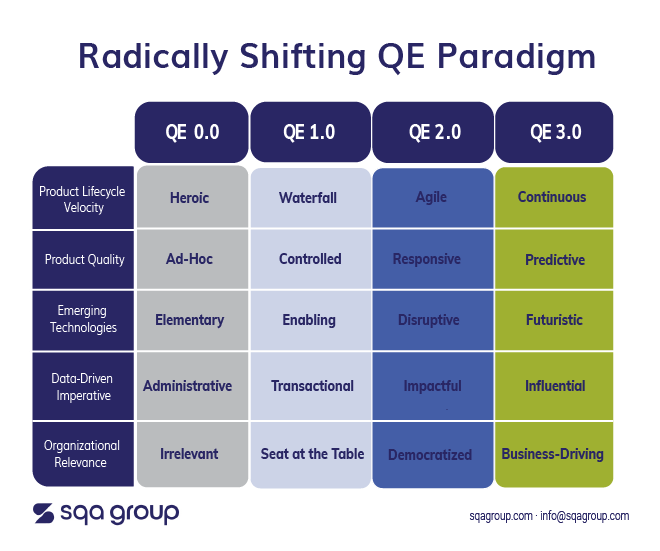The role of a QE leader is shifting fast, particularly as we face mounting pressure to accelerate product lifecycle velocity, introduce emerging technologies, navigate ever-expanding integration capabilities, and become a truly data-driven function, among other focus areas.
We have moved well beyond the 0.0 and 1.0 QE eras, which were largely characterized by reactive testing, year-long projects, manual data collection, and quality assurance — not engineering — recognized as the discipline. We are officially in the era of 2.0, defined by our commitment and investment in Agile development, devops-driven continuous release and delivery of code, business resiliency, and near-real time feedback loops and analytics. But at the pace at which product expectations, user behavior and business demand move, we cannot remain in the current paradigm for too long.
To be honest, QE 2.0 is quickly becoming table stakes. The business expects us to have at least pushed our departments forward to this paradigm.
That means QE 3.0 — the era of continuous everything — is right around the corner. And we need to be ready.
We need to realize opportunity and advancement in today’s 2.0 paradigm, while preparing to have maximum impact in tomorrow’s 3.0 world. To best prepare for what’s coming, it’s important that we understand just how fast the paradigm is shifting, with specific focus on where we’ve been and where we’re headed.

Gaining Influence
If you think about the 0.0 days, QE didn’t even exist. Rather, the business had an IT department that was very much tucked away in the basement, and that department handled testing as a reactive part of development and incorporated very limited user input. The business would talk to us engineers and then we would go back in the room and do our magic, albeit with little to no visibility offered to the product owners or the end users who would consume the results of the calculations that were made.
But over the years, quality assurance started to emerge as a separate bureau in service to IT. The business determined that in order to get products that were fit-for-purpose, they needed a separate team that had hyper-expertise with testing. Thus began the QE 1.0 era, where quality assurance evolved as a specific phase in the SDLC.
When quality emerged as a bureau, two new problems surfaced. Just as there had been a problem of translation from the business to IT, now there was a problem of translation from IT to QE. There were shifting expectations in what was being built and what needed to be tested, which would cause slowdowns and repetitive cycles.
To solve these problems, QE needed to be incorporated into the whole lifecycle and this began the democratization of QE, or what we refer to today as the 2.0 era. This paradigm is characterized by things like extensive automation, integration with the build process, shift-left, shift-right testing, and leveraging nascent technologies. The expectation about what we can do as a QE department continues to burgeon, and we are getting closer to end users in a way we never have previously.
In many ways, 2.0 represents our most influential era to date, as we are impacting things like go-to-market, product differentiation and revenue impact in a more profound way. We are knee-deep in the true re-institution of an engineering discipline.
But as leaders, we can’t get too comfortable in 2.0 because 3.0 is coming around the corner… FAST.
Preparing for 3.0
As compared to the other paradigm shifts, 3.0 is going to be driven by possibilities created by new technology that in many cases weren’t even imagined before.
3.0 will present opportunity and advancement such as…
Quality bolted on, not built in
Timely innovation and speed to adoption
AI-based modeling and automated algorithms
KPIs we haven’t even yet conceived to measure our impact
The redefinition of IT systems
3.0 will be characterized by phrases like continuous, predictive, futuristic, influential, dynamically defined, and technology-enabled. It will be an incredibly exciting era where some of our most innovative, business-driving work will soar.
In many ways, the previous eras have all prepared us for this moment… a time in which QE becomes a competitive advantage and growth driver enmeshed in the DNA of an organization.
In QE 0.0, there was no seat at the table. In 1.0, we got a seat but not an equal one. In 2.0, our seat is starting to get more equal. In 3.0, we will have one of the most important, business-defining seats.
Will we be ready? Will we be among the Early Adopters ensuring our organizations and departments embrace 3.0 expediently? What can we do today and what do we need to do tomorrow to best position our QE disciplines to thrive?
In the coming weeks I will be diving into the 2.0 to 3.0 paradigm shift in greater detail. In the meantime, I’d love to connect with you and offer quick tips to help you drive velocity in this shifting paradigm. Click here to schedule a 20-minute call with me.
Until next time…
Related Reading:

